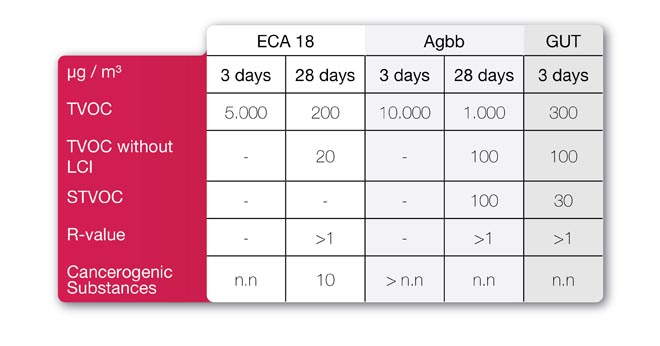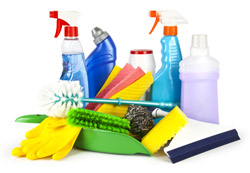The chemicals used in the manufacturing of carpet, interior furnishings and building materials may release volatile organic compounds (VOCs) through a process known as off-gassing. Carpet can release volatile organic compounds into the air, especially when first installed. Emissions from new carpet are among the lowest of any household’s indoor furnishings and the most important potential source of VOCs is a component (styrene) of the latex used for the carpet’s backing. Other, less significant sources are dyestuffs and textile auxiliaries, if these have not been completely rinsed out during the process.
Less chemicals in carpet
In response, the carpet industry has reformulated carpets to reduce VOC emissions and may air out the carpets before installation. VOC levels tend to drop quickly over time.
Over the last 20 years, AW has monitored and reduced the VOC emissions from its products year on year, along with the other carpet manufacturers that make up GUT (Gemeinschaft Umweltfreundlicher Teppichboden e.V.). The limits established by GUT (emission values not to be exceeded) were also lowered sharply each year. These limits are many times lower than those used by AgBB* and the European Commission**, for example.
Today, a carpet that meets the GUT test’s strict criteria will in no way contribute to the pollution of indoor air. Only during the first weeks will extremely small quantities of VOCs, posing no health risk, be released. After this short period, emission will cease. In other words: fitted carpet is safe and poses no health risk whatsoever.

As well as limits on VOC emissions, GUT has also banned a number of substances from use in the production of carpets, or has established strict limits that must not be exceeded. This covers certain dye accelerators, colour agents, flame retardants and active biocidal substances.
If gluing a wall-to-wall carpet: do not use solvent-based adhesives. These can cause significant VOC emissions. There are plenty of solvent-free alternatives available for gluing your carpet.
* AgBB: Ausschuss zur gesundheitliche Bewertung von Bauprodukten, a German institution responsible for the health-related evaluation of construction products.
** ECA: “European Collaborative Action” Indoor Air Quality & Its Impact on Man, Chapter 5 of Report No 18.
Volatile Organic Compounds (VOC)
Volatile Organic Compounds. This is the collective name for a range of hydrocarbon compounds that evaporate readily at room temperature. Three kinds of VOCs can be found in household products:
- Formaldehyde: this substance is used in industry as a preservation and bonding agent. It occurs in furniture and fabrics, but also in hundreds of household products.
- Organochloride: a large collection of, often powerful, chemicals. This group includes pesticides, solvents, cleaning fluids, PVC and PCBs, for example.
- Phenol or carbolic acid is commonly used as a disinfectant, but also in hard plastic, paint, fabric paint and varnish.
Specialists disagree on the extent of the problems caused by VOCs. According to some experts, most people are unaffected, whilst the substances trigger allergic reaction-like symptoms in some individuals. Others suggest that the combined vapours from VOCs are toxic and trigger irritation for almost everyone. The majority of VOCs are synthetic. They also occur in nature, however, in the citrus aroma of an orange, for example. VOCs cause irritation of the eye membranes, nose and throat problems, headaches, allergic skin reactions, nausea, fatigue and dizziness, for example. The concentration of VOCs is higher indoors than outdoors. Formaldehyde, organochloride and phenolic compounds carry the highest risk. People most often come into contact with VOCs through substances in paint and glue, housework products and pesticides.

The average house contains about 40 volatile organic compounds. We use thousands of products, often daily, that emit VOCs at room temperature. Among them are many household, gardening and kitchen products such as fabric softeners, paints, personal care products, cleaning products, construction materials and stationery products like glue, tape, markers, etc.
If you are using products that emit VOCs, ensure that your house is well ventilated. Tins of unused paint should ideally not be stored inside the house. Also, try to avoid sources of VOCs as far as possible.